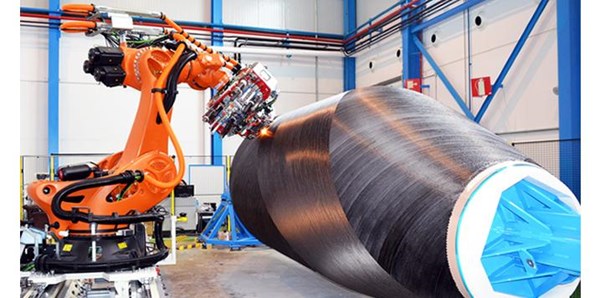A new paradigm in airframe construction?
MTorres, a major supplier of automated manufacturing equipment for composites, has revealed a new way to manufacture airframe structure using composites.

An MTorres head lays dry carbon fiber on the company's new fuselage concept.
I heard the news, through CW colleague Ginger Gardiner and composites industry and aviation researcher and professor Dr. David Pritchard, that Spanish industrial group MTorres (Torres de Elorz, Navarra, Spain), a major supplier of automated manufacturing equipment for composites, had revealed an entirely new and radically different way to manufacture airframe structure using composites. When I had spoken with the company in March at JEC World in Paris, they said that an announcement would be coming at the upcoming Paris Air Show, but gave no hint of its magnitude.
The company did speak on May 26th with journalists from Madrid’s largest newspaper El Pais during an event at MTorres’ facility in Fuente Alamo, Spain, and unveiled the new technology, which consists of a one-piece, monocoque fuselage that it says requires no rivets or fasteners, nor molds. Developed over the past 6 months by a team of 30 people, including company founder Manuel Torres, project head Sebastián Díaz was quoted in the El Pais article as saying the new fuselage technology “changes the current manufacturing paradigm" of aircraft.
I’ve submitted questions to MTorres, and am waiting for more specifics. But, as we reported in our News item (http://www.compositesworld.com/news/revolutionary-fuselage-concept-unveiled-by-mtorres ), the concept apparently may involve producing C-frames or ring frames in a separate process, with frames held together to create an outer mold line (OML) surface, over which the fuselage skin is fiber placed using MTorres’ fiber placement head and dry carbon fiber tape. The frames are reportedly integrated into the fuselage. The structure is then infused, says MTorres, and oven cured. The company says that the "final phase" of the material used in production, possibly the dry tape itself, is made by MTorres (more information on all materials is coming), which could reduce raw material cost by up to 50%, according to the El Pais story. By eliminating rivets, fuselage weight can be reduced by 10% to 30%, said MTorres at the May 26 event, and tooling costs as well as labor costs would be significantly reduced. Spanish press reports quote MTorres as saying that 6,000 hours of work were saved with this new fabrication concept, compared to existing methods. While the prototype presented is a fuselage, MTorres is reportedly also adapting the technology to wings, as well.
An MTorres spokesperson told CW “So far we have seen huge interest. This concept is the result of a 360º analysis, trying to cut costs on material, on tooling, on processes, on cycle time, while increasing quality using the latest technology available.” If you’re attending the Paris Air Show, from June 19-25, a prototype-scale fuselage made using this technology will be displayed at the MTorres booth, Hall 1 Stand G318. Here's a link to the MTorres press release about the Paris Air Show and the new technology: http://www.mtorres.es/en/communication/news/latest-technological-developments-mtorres-le-bourget-2017.
For his help, CW thanks Pritchard, who is Associate Professor/Aviation Researcher at State University of New York-Empire State College (Saratoga Springs, NY, US) and author of “Aerospace 4.0: Implications to the New Manufacturing Ecosystem”, a paper presented at the Civil Aircraft Industry International Forum (May 10-11, 2017, Shanghai, China).
We will get more information and keep you posted on this, and if you have more information about this concept, please contact me.
Related Content
Cryo-compressed hydrogen, the best solution for storage and refueling stations?
Cryomotive’s CRYOGAS solution claims the highest storage density, lowest refueling cost and widest operating range without H2 losses while using one-fifth the carbon fiber required in compressed gas tanks.
Read MoreThe lessons behind OceanGate
Carbon fiber composites faced much criticism in the wake of the OceanGate submersible accident. CW’s publisher Jeff Sloan explains that it’s not that simple.
Read MorePlant tour: Teijin Carbon America Inc., Greenwood, S.C., U.S.
In 2018, Teijin broke ground on a facility that is reportedly the largest capacity carbon fiber line currently in existence. The line has been fully functional for nearly two years and has plenty of room for expansion.
Read MoreManufacturing the MFFD thermoplastic composite fuselage
Demonstrator’s upper, lower shells and assembly prove materials and new processes for lighter, cheaper and more sustainable high-rate future aircraft.
Read MoreRead Next
Plant tour: Daher Shap’in TechCenter and composites production plant, Saint-Aignan-de-Grandlieu, France
Co-located R&D and production advance OOA thermosets, thermoplastics, welding, recycling and digital technologies for faster processing and certification of lighter, more sustainable composites.
Read More“Structured air” TPS safeguards composite structures
Powered by an 85% air/15% pure polyimide aerogel, Blueshift’s novel material system protects structures during transient thermal events from -200°C to beyond 2400°C for rockets, battery boxes and more.
Read MoreVIDEO: High-volume processing for fiberglass components
Cannon Ergos, a company specializing in high-ton presses and equipment for composites fabrication and plastics processing, displayed automotive and industrial components at CAMX 2024.
Read More





















